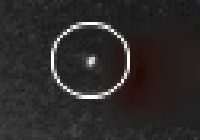Desdemona (moon)
| Desdemona | |
|---|---|
| Voyager 2 discovery image from Desdemona | |
| Provisional or systematic name | S / 1986 U 6 |
| Central body | Uranus |
| Properties of the orbit | |
| Major semi-axis | 62,658.364 ± 0.047 km |
| Periapsis | 62,650.218 km |
| Apoapsis | 62,666.509 km |
| eccentricity | 0.00013 ± 0.000070 |
| Orbit inclination | 0.11252 ± 0.037 (equatorial plane) ° |
| Orbital time | 0.473649597 ± 0.000000014 d |
| Mean orbital velocity | 9.6203 km / s |
| Physical Properties | |
| Albedo | 0.08 ± 0.01 |
| Apparent brightness | 21.99 ± 0.16 mag |
| Medium diameter | 64.0 ± 8 (90 × 54 × 54) km |
| Dimensions | ≈ 178,341,543,538,566,000 kg |
| surface | ~ 12,867.96 km 2 |
| Medium density | ≈ 1.3 g / cm 3 |
| Acceleration of gravity on the surface | ≈ 0.0116 m / s 2 |
| Escape speed | ≈ 27.0 m / s |
| Surface temperature | ≈ −184 ° C to −209 ° C / 64–89 K |
| discovery | |
| Explorer |
Voyager 2 |
| Date of discovery | January 13, 1986 |
| Remarks | Physical data relatively imprecise. |
Desdemona (also Uranus X ) is the fifth innermost and one of the smaller of the 27 known moons of the planet Uranus .
Discovery and naming
Desdemona was discovered on January 13, 1986 by the astronomer Stephen P. Synnott ( Voyager Science Team) together with Rosalind and Belinda on photographs taken by the Voyager 2 space probe . The discovery was announced on January 16, 1986 by the International Astronomical Union (IAU); the moon was initially given the provisional designation S / 1986 U 6 .
Desdemona is the wife of the Venetian general Othello from William Shakespeare's tragedy Othello, the Moor of Venice . She is the daughter of Brabantio, who secretly marries Othello against his blessing, which Iago betrays; this tries to discredit Cassio at Othello in order to obtain his post. Through an intrigue, Iago succeeds in convincing Othello of an alleged infidelity between Desdemona and Cassio. Desdemona is then strangled in raging jealousy by Othello. When Othello is later cleared up about the facts, he stabs himself.
The name Desdemona or Disdemona is possibly derived from the Greek dysdaimôn ("unhappy", "standing under a starlight", "persecuted by fate").
All the moons of Uranus are named after characters from Shakespeare or Alexander Pope . The first four Uranus moons discovered ( Oberon , Titania , Ariel , Umbriel ) were named after suggestions by John Herschel , the son of the Uranus discoverer Wilhelm Herschel . Later the tradition of naming was retained.
Track properties
Orbit
Desdemona orbits Uranus on a prograde , almost perfectly circular orbit at an average distance of around 62,658 km (approx. 2,452 Uranus radii) from its center, i.e. 37,099 km above its cloud ceiling. The orbit eccentricity is 0.00013, the orbit is 0.11252 ° inclined to the equator of Uranus .
Desdemona is the third innermost moon in the Portia group , which also includes Bianca , Cressida , Juliet , Portia , Rosalind , Cupid , Belinda and Perdita . These moons have similar orbits and similar spectral properties.
The orbit of the next inner moon Cressida is on average only 892 km away from Cressida's orbit, that of the next outer moon Juliet is almost exactly 1,700 km away.
Desdemona is located in the middle of two Uranus rings, the inner ε (epsilon) ring , which is on average around 11,509 km away from Desdemona orbit, and the inner edge of the outer ν (Ny) dust ring at a distance of 3,442 km.
Desdemona orbits Uranus in 11 hours, 22 minutes and 3.33 seconds. Since this is faster than the rotation of Uranus, Desdemona rises in the west and sets in the east as seen from Uranus.
rotation
It is assumed that Desdemona rotates synchronously and that its axis has an inclination of 0 °.
Physical Properties
Desdemona has a mean diameter of 64.0 km. In the Voyager 2 footage , Desdemona appeared as an elongated object measuring 90 × 54 × 54 km, with the long axis aligned with Uranus.
Its mean density of 1.3 g / cm 3 is significantly lower than the density of the earth and indicates that the moon is mainly composed of water ice .
Desdemona has a very low albedo of 0.08; That is, 8% of the incident sunlight is reflected from the surface. It is therefore a very dark celestial body.
On its surface, the acceleration due to gravity is 0.0116 m / s 2 , which corresponds to about 1 ‰ of that on earth. The mean surface temperature of Desdemona is estimated to be between −184 ° C and −209 ° C (89–64 K ).
The surface of Desdemona appears gray in the spectrum .
It is possible that Desdemona will collide with the inner Cressida, nearly 900 km away, or the outer Juliet, 1,700 km away, within the next 100 million years .
exploration
Since Voyager 2's flyby, the Uranus system has been studied extensively by both Earth-based observations and the Hubble Space Telescope . The orbit parameters of Desdemona could be specified more precisely.
Web links
- IAUC 4164: Satellites of Uranus January 16, 1986 (discovery)
- IAUC 4165: Satellites of Uranus January 17, 1986 (Correction to IAUC 4164)
- IAUC 4609: Satellites of Saturn and Uranus June 8, 1988 (numbering and naming)
- Polish moon page: Desdemona description and further links (English)
- Satellite Viewer Orbit simulation of the Uranus moons

